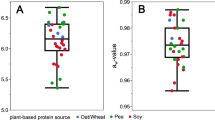Abstract
This study aimed to evaluate the suitability of total aerobic plate count (APC) guidelines for raw pork (< 1 × 107 CFU/g) distributed in Korea. The APC values for raw pork collected from meat packing centers and meat shops in three provinces (Seoul/Gyeonggi, Gangwon, and Chungcheong) were reported to be ≤ 1.5 × 106 CFU/g. To evaluate practical APC guidelines for pork and meat quality, APC levels and quality traits were determined for pork under cold storage. On day 12, APC for pork was 4.3 × 106 CFU/g, which was below the guideline level, while overall acceptability scores were < 3.0, indicating that the pork was rated as not acceptable by sensory panels. Therefore, to satisfy both the microbiological safety of pork and organoleptic quality for consumer palatability, we suggest that the current APC guideline levels for pork should be lowered to 1 × 106 CFU/g.
Similar content being viewed by others
References
Raeisi M, Tabaraei A, Hashemi M, Behnampour N. Effect of sodium alginate coating incorporated with nisin, Cinnamomum zeylanicum, and rosemary essential oils on microbial quality of chicken meat and fate of Listeria monocytogenes during refrigeration. Int. J. Food Microbiol. 238: 139–145 (2016)
Kim HW, Lee JY, Hong WS, Hwang SM, Lee V, Rhim SR, Paik DH. Overview of real-time visibility system for food (Livestock Products) transportation systems on HACCP application and systematization. Korean J. Food Sci. An. 30: 896–904 (2010)
Organization for Economic Cooperation and Development (OECD). Meat consumption (indicator). Available from: https://doi.org/10.1787/fa290fd0-en. Accessed Oct. 8, 2017.
Bruckner S, Albrecht A, Petersen B, Kreyenschmidt J. Characterization and comparison of spoilage processes in fresh pork and poultry. J. Food Qual. 35: 372–382 (2012)
Lorenzo JM, Gómez M. Shelf life of fresh foal meat under MAP, overwrap and vacuum packing conditions. Meat Sci. 92: 610–618 (2012)
Duffy EA, Belk KE, Sofos JN, Bellinger GR, Pape A, Smith GC. Extent of microbial contamination in United States pork retail products. J. Food Prot. 64: 172–178 (2001)
Kaneki N, Miura T, Shimada K, Tanaka H, Ito S, Hotori K, Akasakae C, Ohkuboe S, Asano Y. Measurement of pork freshness using potentiometric sensor. Talanta 62: 215–219 (2004)
Dainty RH, Mackey BM. The relationship between the phenotypic properties of bacteria from chill stored meat and spoilage processes. J. Appl. Bacteriol. 73: 103–114 (1992)
Nychas GJE, Skandamis PN, Tassou CC, Koutsoumanis KP. Meat spoilage during distribution. Meat Sci. 78: 77–89 (2008)
Tang X, Sun X, Wu VC, Xie J, Pan Y, Zhao Y, Malakar PK. Predicting shelf-life of chilled pork sold in China. Food Control 32: 334–340 (2013)
Kim JH, Kim KH, Song SW, Lee JY, Jung SC, Lee SW. A survey on the microbial contamination levels for meats in distributional stages. QIA. (2005)
Huang J, Zong Q, Zhao F, Zhu J, Jiao XA. Quantitative surveys of Salmonella and Campylobacter on retail raw chicken in Yangzhou, China. Food Control 59: 68–73 (2016)
Jeon HC, Kim JE, Son JW, Chae HS, Jin KS, Oh JH, Shin BW, Lee JH. Evaluation of the microbial contamination status and sanitation practice level in butcher’s shops in Seoul. Korean J. Vet. Serv. 34: 409–416 (2011)
Kim YH, Ryu K, Lee YK. Microbiological safety during delivering of food ingredients supplied to elementary school food services in Daegu and Gyeongbuk provinces-seafood, meat and frozen processing food. Korean J. Food Preserv. 16: 276–285 (2009)
Yang YM, Son JW, Choi TS, Park M, Kim JY, Lee JH, Shin BW. A survey of the microbial contamination level in butcher’s shops in Seoul, Korea. Korean J. Vet. Serv. 36: 203–208 (2013)
Gil L, Barat JM, Baigts D, Martínez-Máñez R, Soto J, Garcia-Breijo E, Aristoyf MC, Toldráf F, Llobet, E. Monitoring of physical–chemical and microbiological changes in fresh pork under cold storage by means of a potentiometric electronic tongue. Food Chem. 126: 1261–1268 (2011)
Blickstad E, Molin G. Carbon dioxide as a controller of the spoilage flora of pork, with special reference to temperature and sodium chloride. J. Food Prot. 46: 756–763 (1983)
Klont RE, Barnier VMH, Smulders FJM, Van Dijk A, Hoving-Bolink AH, Eikelenboom G. Post-mortem variation in pH, temperature, and colour profiles of veal carcasses in relation to breed, blood haemoglobin content, and carcass characteristics. Meat Sci. 53: 195–202 (1999)
Borch E, Kant-Muermans ML, Blixt Y. Bacterial spoilage of meat and cured meat products. Int. J. Food Microbiol. 33: 103–120 (1996)
Demeyer DI, Vandekerckhove P, Moermans R. Compounds determining pH in dry sausage. Meat Sci. 3: 161–167 (1979)
Lee KT, Choi WS, Yoon CS. Effects of micro-perforated film on the quality and shelf life improvements of pork loins during chilled storage. Meat Sci. 66: 77–82 (2004)
Ko MS, Yang JB. Effects of wrap and vacuum packing on shelf life of chilled pork. Korean J. Food Nutr. 14: 255–262 (2001)
Vaikousi H, Biliaderis CG, Koutsoumanis, KP. Applicability of a microbial Time Temperature Indicator (TTI) for monitoring spoilage of modified atmosphere packed minced meat. Int. J. Food Microbiol. 133: 272–278 (2009)
Ye X, Iino K, Zhang S. Monitoring of bacterial contamination on chicken meat surface using a novel narrowband spectral index derived from hyperspectral imagery data. Meat Sci. 122: 25–31 (2016)
Acknowledgements
This work was carried out with the support of Ministry of Food and Drug Safety, Republic of Korea. Also this study was partially supported by Brain Korea 21 plus project (Human Resource Development for Next Generation Animal Life Industry with ICT-Big Data) from the Ministry of Education and Human Resources Development in Korea.
Author information
Authors and Affiliations
Corresponding author
Ethics declarations
Conflict of interest
The authors declare that they have no conflict of interest.
Rights and permissions
About this article
Cite this article
Kim, HJ., Jang, A. Evaluation of the microbiological status of raw pork meat in Korea: modification of the microbial guideline levels for meat. Food Sci Biotechnol 27, 1219–1225 (2018). https://doi.org/10.1007/s10068-018-0356-7
Received:
Revised:
Accepted:
Published:
Issue Date:
DOI: https://doi.org/10.1007/s10068-018-0356-7




